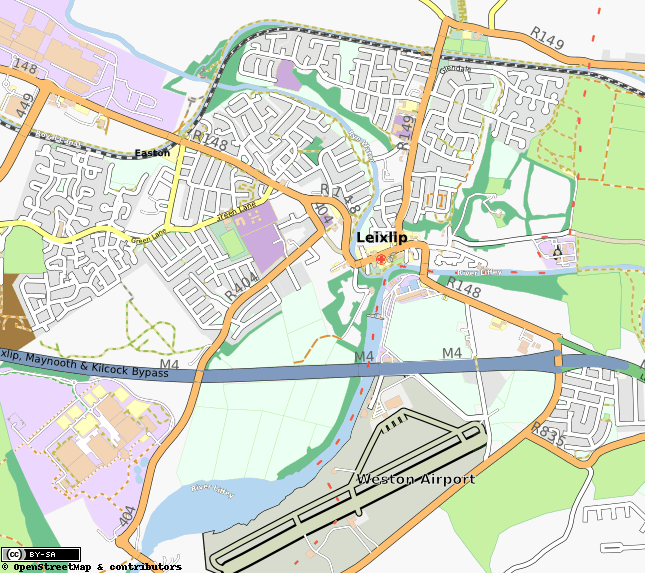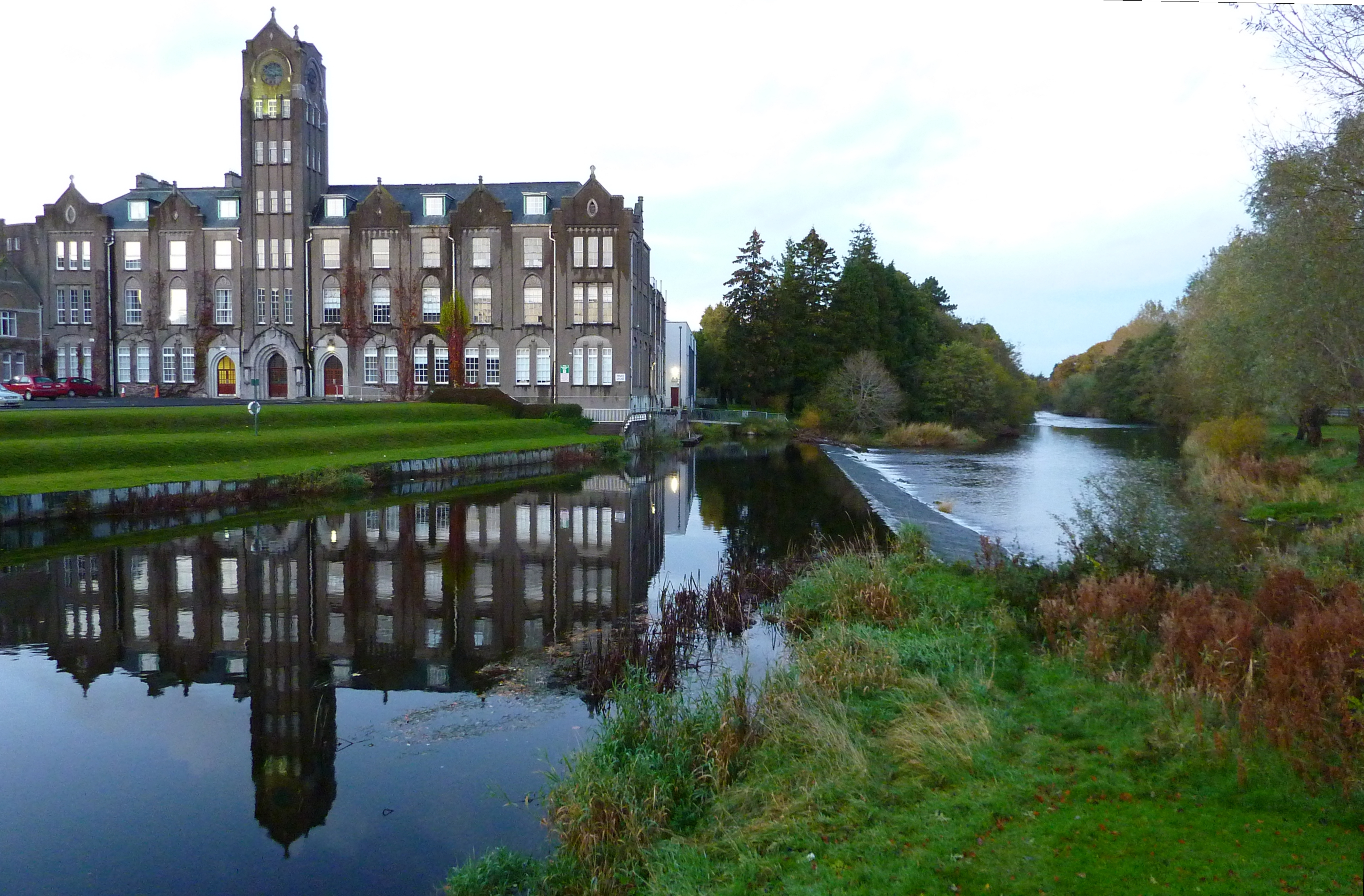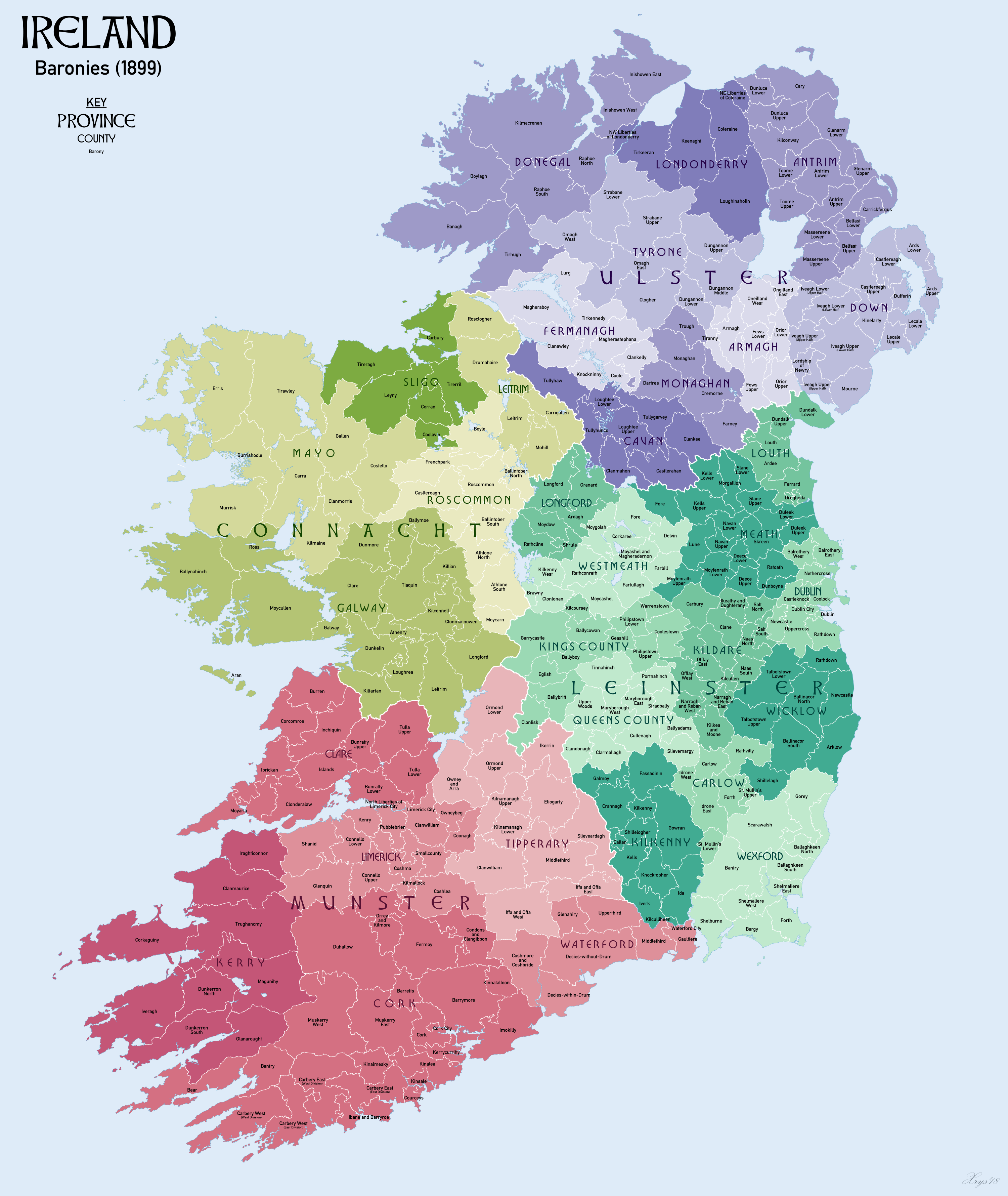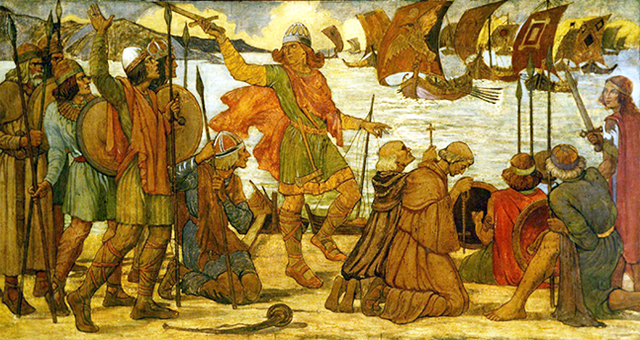|
Leixlip, County Kildare
Leixlip ( or ; , ) is a town in north-east County Kildare, Ireland. Its location on the confluence of the River Liffey and the Rye Water has marked it as a frontier town historically: on the border between the ancient kingdoms of Leinster and Brega, as an outpost of The Pale, and on Kildare's border with County Dublin. Leixlip was also a civil parish in the ancient barony of Salt North. As of 2022, the population of the town was 16,773. It is the fifth largest town in Kildare, and the 30th largest in Ireland. Name The placename comes from the Old Norse ''lax hlaup'' ( Younger Futhark: ᛚᛅᚼᛋ ᚼᛚᛅᚢᛒ; ) which means "salmon leap". The name in the Irish language (''Léim an Bhradáin'') is a direct translation of this, and was first adopted in the 1890s. In Latin, it is ''Saltus salmonis'', from which comes the names of the baronies of North Salt and South Salt. History Leixlip was a possible site of the Battle of Confey, in which the Viking King Sigtrygg Caech ... [...More Info...] [...Related Items...] OR: [Wikipedia] [Google] [Baidu] |
Provinces Of Ireland
There are four provinces of Ireland: Connacht, Leinster, Munster and Ulster. The Irish language, Irish word for this territorial division, , meaning "fifth part", suggests that there were once five, and at times Kingdom of Meath, Meath has been considered to be the fifth province. In the medieval period, however, there were often more than five. The number of provinces and their delimitation fluctuated until 1610, when they were permanently set by the English administration of James VI and I, James I. The provinces of Ireland no longer serve administrative or political purposes but function as historical and cultural entities. Etymology In modern Irish language, Irish, the word for province is (pl. ). The modern Irish term derives from the Old Irish (pl. ) which literally meant "a fifth". This term appears in 8th-century law texts such as and in the legendary tales of the Ulster Cycle where it refers to the five kingdoms of the "Pentarchy". MacNeill enumerates the five earl ... [...More Info...] [...Related Items...] OR: [Wikipedia] [Google] [Baidu] |
River Liffey
The River Liffey (Irish language, Irish: ''An Life'', historically ''An Ruirthe(a)ch'') is a river in eastern Ireland that ultimately flows through the centre of Dublin to its mouth within Dublin Bay. Its major Tributary, tributaries include the River Dodder, the River Poddle and the River Camac. The river supplies much of Dublin's water and supports a range of recreational activities. Name While Ptolemy's ''Geography (Ptolemy), Geography'' (2nd century AD) describes a river which he labels Οβοκα (''Oboka''), this is not the Liffey: ultimately it leads to the name of the River Avoca in County Wicklow. According to "Place Names from our Older Literature - IV." by Boswell, C. S. (1904 Connradh na Gaedhilge) the river takes its name from Magh Life, i.e. the plain of Kildare through which the Life flows. This in turn takes its name from Life, daughter of Canann Curthach, who eloped with and married Deltbanna mac Druchta, cup-bearer to Conaire Mór High King of Ireland. Life ... [...More Info...] [...Related Items...] OR: [Wikipedia] [Google] [Baidu] |
Irish Language
Irish (Standard Irish: ), also known as Irish Gaelic or simply Gaelic ( ), is a Celtic language of the Indo-European language family. It is a member of the Goidelic languages of the Insular Celtic sub branch of the family and is indigenous language, indigenous to the island of Ireland. It was the majority of the population's first language until the 19th century, when English (language), English gradually became dominant, particularly in the last decades of the century, in what is sometimes characterised as a result of linguistic imperialism. Today, Irish is still commonly spoken as a first language in Ireland's Gaeltacht regions, in which 2% of Ireland's population lived in 2022. The total number of people (aged 3 and over) in Ireland who declared they could speak Irish in April 2022 was 1,873,997, representing 40% of respondents, but of these, 472,887 said they never spoke it and a further 551,993 said they only spoke it within the education system. Linguistic analyses o ... [...More Info...] [...Related Items...] OR: [Wikipedia] [Google] [Baidu] |
Salmon
Salmon (; : salmon) are any of several list of commercially important fish species, commercially important species of euryhaline ray-finned fish from the genera ''Salmo'' and ''Oncorhynchus'' of the family (biology), family Salmonidae, native to tributary, tributaries of the North Atlantic (''Salmo'') and North Pacific (''Oncorhynchus'') basins. ''Salmon'' is a colloquial or common name used for fish in this group, but is not a scientific name. Other closely related fish in the same family include trout, Salvelinus, char, Thymallus, grayling, Freshwater whitefish, whitefish, lenok and Hucho, taimen, all coldwater fish of the subarctic and cooler temperate regions with some sporadic endorheic populations in Central Asia. Salmon are typically fish migration, anadromous: they hatch in the shallow gravel stream bed, beds of freshwater headstreams and spend their juvenile fish, juvenile years in rivers, lakes and freshwater wetlands, migrate to the ocean as adults and live like sea ... [...More Info...] [...Related Items...] OR: [Wikipedia] [Google] [Baidu] |
Old Norse
Old Norse, also referred to as Old Nordic or Old Scandinavian, was a stage of development of North Germanic languages, North Germanic dialects before their final divergence into separate Nordic languages. Old Norse was spoken by inhabitants of Scandinavia and their Viking expansion, overseas settlements and chronologically coincides with the Viking Age, the Christianization of Scandinavia, and the consolidation of Scandinavian kingdoms from about the 8th to the 15th centuries. The Proto-Norse language developed into Old Norse by the 8th century, and Old Norse began to develop into the modern North Germanic languages in the mid- to late 14th century, ending the language phase known as Old Norse. These dates, however, are not precise, since written Old Norse is found well into the 15th century. Old Norse was divided into three dialects: Old West Norse (Old West Nordic, often referred to as ''Old Norse''), Old East Norse (Old East Nordic), and Old Gutnish. Old West Norse and O ... [...More Info...] [...Related Items...] OR: [Wikipedia] [Google] [Baidu] |
List Of Urban Areas In The Republic Of Ireland
This is a list of urban areas in the Republic of Ireland by population. In 2022, the Central Statistics Office (CSO), the Department of Housing, Local Government and Heritage and Tailte Éireann created of a new unit of urban geography called Built Up Areas (BUAs) which were used to produce data for urban areas in the 2022 census of Ireland. There were 867 BUAs, representing the entire settlement area of each town and city (including suburbs and environs). The 250 largest cities, towns and villages are listed below with data from the 2022 census. Cities and towns list Notes GPO Portico - Morning.jpg, 1st, Dublin Cork City Hall, February 2018.jpg, 2nd, Cork LimerickCity Riverpoint.jpg, 3rd, Limerick Galway Harbour 2007.jpg, 4th, Galway Waterford city at night - geograph.org.uk - 1034017.jpg, 5th, Waterford Drogheda2005.jpg, 6th, Drogheda Dkit1 1024x768.jpg, 7th, Dundalk North Street, Swords, Co. Dublin - geograph.org.uk - 381905.jpg, 8th, Swords Poolboy Bridge, Navan - g ... [...More Info...] [...Related Items...] OR: [Wikipedia] [Google] [Baidu] |
Salt North
Salt North () is a barony in County Kildare, Ireland. Etymology Salt North derives its name from the Latin name of Leixlip: ''Saltus salmonis'' (literally "salmon leap"; the English name is derived from Old Norse ''Lax-hlaup''). This makes Salt one of very few Irish placenames derived directly from Latin. Location Salt North barony is located in the north-eastern corner of County Kildare, north of the River Liffey and east of the Lyreen River. It borders County Meath to the north and Fingal to the east. History The Uí Gabla sept of the Dál Chormaic is noted early in Salt North. Ó Gelbroin is found as a chief of Mag Life on the plains of the river Liffey here. There was originally a single Salt barony, divided into north and south baronies before 1807. List of settlements Below is a list of settlements in North Salt: *Celbridge *Leixlip *Maynooth *Straffan Below is a list of civil parishes in North Salt: *Leixlip (civil parish) Leixlip () is a Civil parishes in Irel ... [...More Info...] [...Related Items...] OR: [Wikipedia] [Google] [Baidu] |
Barony (Ireland)
In Ireland, a barony (, plural ) is a historical subdivision of a counties of Ireland, county, analogous to the hundred (county subdivision), hundreds into which the counties of England were divided. Baronies were created during the Tudor reconquest of Ireland, replacing the earlier cantreds formed after the original Norman invasion of Ireland, Norman invasion.Mac Cotter 2005, pp.327–330 Some early baronies were later subdivided into half baronies with the same standing as full baronies. Baronies were mainly cadastre, cadastral rather than administrative units. They acquired modest local taxation and spending functions in the 19th century before being superseded by the Local Government (Ireland) Act 1898. Subsequent adjustments of county boundaries mean that some baronies now straddle two counties. The final catalogue of baronies numbered 331, with an average area of ; each county was divided, on average, into 10 or 11 baronies. Creation The island of Ireland was "shired" i ... [...More Info...] [...Related Items...] OR: [Wikipedia] [Google] [Baidu] |
Civil Parishes In Ireland
Civil parishes () are units of territory in the island of Ireland that have their origins in old Gaelic territorial divisions. They were adopted by the Anglo-Norman Lordship of Ireland and then by the Elizabethan Kingdom of Ireland, and were formalised as land divisions at the time of the Plantations of Ireland. They no longer correspond to the boundaries of Roman Catholic or Church of Ireland parishes, which are generally larger. Their use as administrative units was gradually replaced by Poor_law_union#Ireland, Poor Law Divisions in the 19th century, although they were not formally abolished. Today they are still sometimes used for legal purposes, such as to locate property in deeds of property registered between 1833 and 1946. Origins The Irish parish was based on the Gaelic territorial unit called a ''túath'' or ''Trícha cét''. Following the Norman invasion of Ireland, the Anglo-Normans, Anglo-Norman barons retained the ''tuath'', later renamed a parish or manor, as a un ... [...More Info...] [...Related Items...] OR: [Wikipedia] [Google] [Baidu] |
Leixlip (civil Parish)
Leixlip () is a Civil parishes in Ireland, civil parish and a townland located in the north-eastern corner of County Kildare, Republic of Ireland, Ireland. The civil parish is mainly in the ancient Barony (Ireland), barony of Salt North with a small part in the neighbouring barony of Newcastle (County Dublin barony), Newcastle. It is centred on the town of Leixlip. In geology, the parish rests on a substratum of limestone, and contains chalybeate springs. It lies at the confluence of the River Liffey and the River Rye (Ireland), Rye Water. History According to Lewis' Topography of Ireland (1837), the parish contained 1624 inhabitants, of which 1159 were in the town and it comprised 7974 statute Acre#United Kingdom, acres. The soil was recorded as "good" with a considerable portion of the land being "in pasture for fattening stock for the Dublin, Liverpool, and Bristol markets, and the remainder is under tillage". Lewis recorded that the living was a Rector (ecclesiastical), recto ... [...More Info...] [...Related Items...] OR: [Wikipedia] [Google] [Baidu] |
County Dublin
County Dublin ( or ) is a Counties of Ireland, county in Republic of Ireland, Ireland, and holds its capital city, Dublin. It is located on the island's east coast, within the Provinces of Ireland, province of Leinster. Until 1994, County Dublin (excluding the city) was a single Local government in the Republic of Ireland, local government area; in that year, the county council was divided into three new administrative counties: Dún Laoghaire–Rathdown, Fingal and South Dublin. The three administrative counties together with Dublin City proper form a NUTS III NUTS statistical regions of Ireland, statistical region of Ireland (coded IE061). County Dublin remains a single administrative unit for the purposes of the courts (including the Dublin County Sheriff, but excluding the bailiwick of the Dublin City Sheriff) and Dublin County combined with Dublin City forms the Judicial County of Dublin, including Dublin Circuit Court, the Dublin County Registrar and the Dublin Metropolitan ... [...More Info...] [...Related Items...] OR: [Wikipedia] [Google] [Baidu] |








